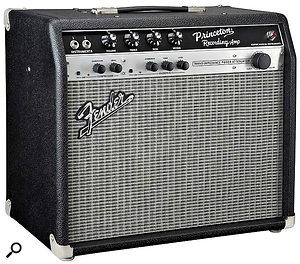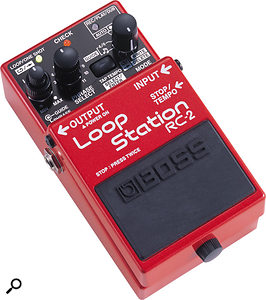Pretty much every guitar player has heard about the Line 6 Pod and the company's modelling guitar amps, but now Line 6 have extended their reach into the bass amplifier market with the Low Down series, the smallest and most portable of which is the LD150 (£341). The LD150 features a single custom 12-inch speaker powered by a 150W amplifier, but if you need more level the LD175 or LD300 Pro models (175W and 300W respectively) should meet your requirements. By using an amplifier design optimised for low-end punch with lots of headroom, and combining this with digital modelling and some clever dynamic processing, Line 6 have managed to produce a very loud, yet compact, bass amp capable of emulating a number of classic bass amps and effects.
The included amp models cover a range of musical styles, and there's also a monophonic bass synth mode. Once you've tweaked your settings, they can be stored as four presets, or if you use a Line 6 Shortboard controller, you can store a further 36 custom patches.
As the amp features a balanced DI output with the same speaker modelling technology found in the Pod range, you can record direct from it. There's a also a headphone output and a mini-jack input for iPods and similar devices, so that you can play along with the tunes of your choice. Now, to the models...
The Clean model was 'inspired by' (as Line 6 put it) the Eden Traveler amp, which is popular for funk and fusion styles. Next up is 'R&B', which is modelled on the sound of a '68 Ampeg B15 Flip Top amp, as used on many Motown recordings. On these first models, the sound can be so clean it almost sounds DI'd, unless you turn up the Drive past the nine o'clock position, but 'dirt' is available on any model if you take the Drive control past the 10 o'clock position.
If heavier genres are your thing, the Rock model is based on the sound of the widely used '74 Ampeg SVT — again, a predominantly clean-sounding amp but with more tonal character. 'Brit' pays tribute to the '68 Marshall Super Bass amp and delivers a warm and dirty Brit-rock sound reminiscent of bands such as Cream, The Who or, with a bit more drive and top, The Stranglers. 'Grind' is designed to deliver a modern rock sound and emulates the sound of a distorted Sansamp PSA1 fed into an Ampeg SVT, but with the ability to use the Drive control to mix in the clean sound of the guitar. This model is seriously dirty, verging on fuzz bass, but being able to layer it with a clean version makes it very usable.
'Synth' is designed to make a bass guitar sound more or less like an analogue bass synth. In this mode you can adjust the waveform from what sounds like a square wave to a detuned sawtooth, and also adjust the filter resonance, cutoff and envelope characteristics. It only tracks single notes but otherwise responds really well to normal playing, providing you play fairly hard and cleanly. If you play with a light touch it can sound a bit messy.
While many bass players use no effects other than maybe compression and EQ, the LD150 provides built-in Envelope Filter, Octaver and Chorus effects. A separate compressor is always available and is modelled after a vintage opto studio compressor. The compression knob, which can broadly be thought of as a 'more compression' knob linked to the threshold, also has an associated threshold LED that glows amber when the input is high enough to force the compressor into action. The amp also features a 'Deep' switch that shapes the tone for what Line 6 describe as 'Supreme Fatness', so be warned!
Most of what you see on the front panel of the LD150 looks like a regular bass amp, with knobs to adjust the drive, bass, low and high mid-range, treble and channel volume. These knobs look very traditional, but the marker dot used to show which way the knob is pointing is rather understated. Depending on which amp model you select, the tone controls behave differently, as they try to remain faithful to the original amplifier's behaviour. Another knob (pictured bottom left) selects from one of the five amp models or the synth model, with positional LEDs to show which model is active. Another adjusts the amount of simulated optical compression, and one more controls the master volume. The built-in effects are all accessed via a single knob divided into three segments for the three effects. Turning the knob changes the effect intensity in an intelligent way.
Above the control knobs are the four channel memory buttons, the Deep switch and a further button to activate the built-in tuner, which uses the button backlights and the amp model LEDs as a display. There are two inputs, one for active and one for passive guitars, and a CAT 5 connector at the rear for the optional foot controller, but there's no digital input for a Variax bass.
The amp is built into a carpet-covered cabinet with its rear underside raked back at 45 degrees, so that the amp can be stood flat on the floor or tilted back. It isn't too heavy, though I wouldn't want to carry it further than necessary in one hand.
The LD150 is easy to use but you need to read the manual at least once, just to make sure you don't miss any of the less obvious features. The first four models offer a wide choice of bass sounds that should suit any normal musical genre, from country and pop to rock, whereas the Grind model is seriously dirty and Synth is, well, seriously synthy, in a cello-from-hell kind of a way. The compressor evens out the volume and adds punch, while the additional effects are fine for the occasions when you need them and sound exactly as they should. The chorus is my favourite but the filter gets pretty close to the Electro Harmonix Bass Balls pedals we used to use in the '70s. The Octaver works fine too, on single notes, and it doesn't shake the amp to bits as I initially suspected it might!
Considering that this is a very small amp, it is immensely loud. What's surprising is how deep and solid the impression of bass is — small combos just aren't supposed to sound like this! When you're in conventional amp territory, the sounds respond just as you'd expect from a much larger amplifier, and you can get the amp to sound as clean or as ragged as you like using the Drive control. To sum up, this is a tremendously versatile amplifier that delivers not only brute-force level but also deep-down punch and tonal finesse. Paul White
SUMMARY: A compact and portable bass amp that doesn't compromise on tone.
Line 6 Europe +44 (0)1327 302700. www.line6.com
NEWS
Boss have produced a new pedal which packs the looping technology found in the RC20XL and RC50 floor units into a compact stomp box. The RC2 Loop Station offers 16 minutes of recording time, and up to 11 separate loops can be layered on top of each other. It also provides useful features that include tap tempo, loop quantise and undo/redo. The RC2 will be available later this year.
 Elsewhere at Summer NAMM, Fender were also unveiling a new valve amp that should interest recording guitarists. The Princeton Recording Amp is a 20W all-valve device with a built-in power attenuator. Like the original Princeton Reverb amps of the 1960s, which were a firm favourite of many studio session players, this new Princeton has a 10-inch Jensen speaker and a tube-driven spring reverb tank. The built-in 'Trans-Impedance' power attenuator is designed to respond to playing dynamics just like the speaker would, and allows the user to crank up the amp while keeping its output at a level suitable for recording. The speaker can even be turned off altogether and the amp's headphone output used instead. There are also two built-in effects — a compressor and a stomp box-style overdrive — which can be switched on or off. The amp itself has two inputs and Volume, Treble, Bass and Reverb controls. Handily, the Princeton Recording Amp also has a speaker-emulating line output with its own volume control and ground-lift switch, plus an effects loop.
Elsewhere at Summer NAMM, Fender were also unveiling a new valve amp that should interest recording guitarists. The Princeton Recording Amp is a 20W all-valve device with a built-in power attenuator. Like the original Princeton Reverb amps of the 1960s, which were a firm favourite of many studio session players, this new Princeton has a 10-inch Jensen speaker and a tube-driven spring reverb tank. The built-in 'Trans-Impedance' power attenuator is designed to respond to playing dynamics just like the speaker would, and allows the user to crank up the amp while keeping its output at a level suitable for recording. The speaker can even be turned off altogether and the amp's headphone output used instead. There are also two built-in effects — a compressor and a stomp box-style overdrive — which can be switched on or off. The amp itself has two inputs and Volume, Treble, Bass and Reverb controls. Handily, the Princeton Recording Amp also has a speaker-emulating line output with its own volume control and ground-lift switch, plus an effects loop.
Among a number of new Peavey products introduced at the Summer NAMM show was the Valve King Royal 8. It's a 5W single-ended Class-A valve amp which uses one 12AX7 valve in the preamp and one EL84 in the power amp. The Royal 8 is equipped with a custom-designed eight-inch speaker and has high- and low-gain inputs, a headphone output and Gain, Tone and Master Volume controls. It's set for release in the fourth quarter of 2006.



